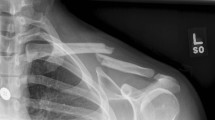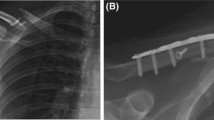Abstract
Although several surgical techniques for midclavicular fractures have been reported, Knowles pinning has rarely been compared with plating. The purpose of this study is to compare the clinical results of these two alternative techniques. There were 88 patients with midclavicular fractures surgically treated with either a Knowles pin or a plate. All patients were followed up for 12 months with a shoulder score evaluation. The Knowles pin group included 56 patients, with an average age of 40.1 years. The plate group included 32 patients, with an average age of 38.2 years. Both groups were similar in injury mechanism and fracture types (all p values>0.5). Plating has a significantly longer operation time, larger wound incision, higher pain level, more analgesic use, more complications and more symptomatic hardware (all p value<0.05). The shoulder score, union rate and healing time are not significantly different between the two groups (all p values>0.2). In conclusion, if the surgery of mid-third clavicular fractures is indicated, fixation with a Knowles pin has more advantages than plate fixation.
Résumé
Plusieurs techniques chirurgicales ont été rapportées pour traiter les fractures de la partie moyenne de la clavicule, l’embrochage étant rarement comparé avec l’ostéosynthèse par plaque. Le propos de cette étude est de comparer les résultats cliniques de ces deux techniques. 88 patients présentant une fracture du tiers moyen de la clavicule ont été traités chirurgicalement par broches de Knowles ou par ostéosynthèses par plaque. Tous les patients ont été suivis pendant une période d’un an avec évaluation clinique de l’épaule. Le groupe broche comportait 56 patients dont l’âge moyen était de 40,1 ans et le groupe des plaques, 32 patients dont l’âge moyen était de 38,2 ans. Les deux groupes avaient le même mécanisme de fracture et le même type de fracture. Les ostéosynthèse par plaques ont conduit un temps opératoire plus important, une incision plus grande et une douleur également plus importante avec utilisation d’un algésique et plus de complications. Par contre l’évaluation de l’épaule, quel que soit le groupe était la même quel que soit le groupe de traitement, plaque ou broche (0.26). En conclusion, l’embrochage par broches de Knowles est une technique plus avantageuse que la fixation par plaque dans les fractures du tiers moyen de la clavicule.

Similar content being viewed by others
References
Ali Khan MA, Lucas HK (1978) Plating of fractures of the middle third of the clavicle. Injury 9(4):263–267
Bigliani LU, Craig EV, Butters KP (1991) Fractures of the shoulder. In: Rockwood CA Jr, Green DP, Bucholz RW (eds) Rockwood and Green’s fractures in adults, 3rd edn. Lippincott-Raven, Philadelphia, Pennsylvania, pp 871–1019
Bostman O, Manninen M, Pihlajamaki H (1997) Complications of plate fixation in fresh displaced midclavicular fractures. J Trauma 43(5):778–783
Bradbury N, Hutchinson J, Hahn D, Colton CL (1996) Clavicular nonunion. 31/32 healed after plate fixation and bone grafting. Acta Orthop Scand 67(4):367–370
Chu CM, Wang SJ, Lin LC (2002) Fixation of mid-third clavicular fractures with Knowles pins: 78 patients followed for 2–7 years. Acta Orthop Scand 73(2):134–139
Constant CR, Murley AH (1987) A clinical method of functional assessment of the shoulder. Clin Orthop Relat Res 214:160–164
Crenshaw AH Jr (2003) Fractures of shoulder, arm, and forearm. In: Canale ST (ed) Campbell’s operative orthopaedics, vol 3, 10th edn. Mosby, Philadelphia, Pennsylvania, pp 2985–3069
Enneking TJMQ, Hartlief MT, Fontijne WPJ (1999) Rushpin fixation for midshaft clavicular nonunions: good results in 13/14 cases. Acta Orthop Scand 70(5):514–516
Grassi FA, Tajana MS, D’Angelo F (2001) Management of midclavicular fractures: comparison between nonoperative treatment and open intramedullary fixation in 80 patients. J Trauma 50(6):1096–1100
Hill JM, McGuire MH, Crosby LA (1997) Closed treatment of displaced middle-third fractures of the clavicle gives poor results. J Bone Joint Surg Br 79(4):537–539
Jubel A, Andermahr J, Schiffer G,Tsironis K,Rehm KE (2003) Elastic stable intramedullary nailing of midclavicular fractures with a titanium nail. Clin Orthop Relat Res 408:279–285
Kernek CB, Robb JA (1986) External callus formation of closed femoral shaft fractures treated by medullary fixation. Orthopedics 9(1):45–51
Kitsis CK, Marino AJ, Krikler SJ, Birch R (2003) Late complications following clavicular fractures and their operative management. Injury 34(1):69–74
Leppilahti J, Jalovaara P (1999) Migration of Kirschner wires following fixation of the clavicle—a report of 2 cases. Acta Orthop Scand 70(5):517–526
Lyons FA, Rockwood CA Jr (1990) Migration of pins used in operations on the shoulder. J Bone Joint Surg Am 72(8):1262–1267
Neviaser RJ (1987) Injuries to the clavicle and acromioclavicular joint. Orthop Clin North Am 18(3):433–438
Ngarmukos C, Parkpian V, Patradul A (1998) Fixation of fractures of the midshaft of the clavicle with Kirschner wires. Results in 108 patients. J Bone Joint Surg Br 80(1):106–108
Niemier U, Zimmermann HG (1990) Kuntscher’s open intramedullary nailing of the clavicle. An alternative in the treatment of an old clavicular fracture (in German). Chirurg 61(6):464–466
Nordqvist A, Petersson CJ, Redlund-Johnell I (1998) Mid-clavicle fractures in adults: end result study after conservative treatment. J Orthop Trauma 12(8):572–576
Petracic B (1983) Efficiency of a rucksack bandage in the treatment of clavicle fractures (in German). Unfallchirurgie 9(1):41–43
Poigenfurst J, Rappold G, Fischer W (1992) Plating of fresh clavicular fractures: results of 122 operations. Injury 23(4):237–241
Postacchini F, Gumina S, De Santis P, Albo F (2002) Epidemiology of clavicle fractures. J Shoulder Elbow Surg 11(5):452–456
Robinson CM (1998) Fractures of the clavicle in the adult. Epidemiology and classification. J Bone Joint Surg Br 80(3):476–484
Rowe CR (1968) An atlas of anatomy and treatment of midclavicular fractures. Clin Orthop Relat Res 58:29–42
Schwarz N, Hocker K (1992) Osteosynthesis of irreducible fractures of the clavicle with 2.7-mm ASIF plates. J Trauma 33(2):179–183
Author information
Authors and Affiliations
Corresponding author
Rights and permissions
About this article
Cite this article
Lee, YS., Huang, HL., Lo, TY. et al. Surgical treatment of midclavicular fractures: a prospective comparison of Knowles pinning and plate fixation. International Orthopaedics (SICO 32, 541–545 (2008). https://doi.org/10.1007/s00264-007-0352-7
Received:
Revised:
Accepted:
Published:
Issue Date:
DOI: https://doi.org/10.1007/s00264-007-0352-7




